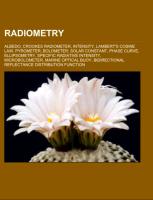- Start
- Radiometry
Radiometry
Angebote / Angebote:
Source: Wikipedia. Pages: 54. Chapters: Albedo, Crookes radiometer, Intensity, Lambert's cosine law, Pyrometer, Bolometer, Solar constant, Phase curve, Ellipsometry, Specific radiative intensity, Microbolometer, Marine Optical Buoy, Bidirectional reflectance distribution function, Sea ice emissivity modelling, Sea ice thickness, Radiant energy, Sea ice concentration, Stokes parameters, Radiative transfer, Special Sensor Microwave/Imager, Spectral sensitivity, Opposition surge, Advanced Spaceborne Thermal Emission and Reflection Radiometer, Photometry, Actinometer, POLDER, Geometric albedo, Net radiometer, Gardon gauge, Irradiance, Bidirectional scattering distribution function, Pyrgeometer, Bond albedo, Lambertian reflectance, DART radiative transfer model, Spectral power distribution, Langley extrapolation, SSMIS, Leslie cube, Phase angle, Thin filament pyrometry, Pyrheliometer, Microwave radiometer, Hapke parameters, Scanning Multichannel Microwave Radiometer, Transition edge sensor, Light intensity, Radiant flux, Radiant intensity, Active cavity radiometer. Excerpt: The solar constant, a measure of flux density, is the amount of incoming solar electromagnetic radiation per unit area that would be incident on a plane perpendicular to the rays, at a distance of one astronomical unit (AU) (roughly the mean distance from the Sun to the Earth). When solar irradiance is measured on the outer surface of Earth's atmosphere, the measurements can be adjusted using the inverse square law to infer the magnitude of solar irradiance at one AU and deduce the solar constant. The solar constant includes all types of solar radiation, not just the visible light. It is measured by satellite to be roughly 1.366 kilowatts per square meter (kW/m²). The actual direct solar irradiance at the top of the atmosphere fluctuates by about 6.9% during a year (from 1.412 kW/m² in early January to 1.321 kW/m² in early July) due to the Earth's varying distance from the Sun, and typically by much less than one part per thousand from day to day. Thus, for the whole Earth (which has a cross section of 127, 400, 000 km²), the power is 1.740×10 W, plus or minus 3.5%. The solar constant does not remain constant over long periods of time (see Solar variation), but over a year varies much less than the variation of direct solar irradiance at the top of the atmosphere arising from the ellipticity of the Earth's orbit. The approximate average value cited, 1.366 kW/m², is equivalent to 1.96 calories per minute per square centimeter, or 1.96 langleys (Ly) per minute. The Earth receives a total amount of radiation determined by its cross section (p·RE²), but as it rotates this energy is distributed across the entire surface area (4·p·RE²). Hence the average incoming solar radiation, taking into account the angle at which the rays strike and that at any one moment half the planet does not receive any solar radiation, is one-fourth the solar constant (approximately 342 W/m²). At any given moment, the amount of solar radiation received at a location on the Earth's surface depends
Folgt in ca. 5 Arbeitstagen
